Photoperiod Affects Leptin Action on the Choroid Plexus in Ewes Challenged with Lipopolysaccharide—Study on the mRNA Level
Abstract
1. Introduction
2. Results
2.1. The Effect of Leptin on the Body Temperature and Hormones Concentrations
2.2. The Effect of Leptin on TLR4 Gene Expression
2.3. The Effect of Leptin on LEPRa, LEPRb, and SOCS3 Gene Expression
2.4. The Effect of Leptin on IL1B, IL1R1, IL1R2 and IL1RN Gene Expression
2.5. The Effect of Leptin on NLRP3, PYCARD and CASP1 Gene Expression
2.6. The Effect of Leptin on IL6, IL6R and IL6ST Gene Expression
2.7. The Effect of Leptin on CCL2 Gene Expression
3. Discussion
4. Materials and Methods
4.1. Animals and Experimental Design
4.2. Hormone Concentration Measurement
4.3. Relative mRNA Expression
4.4. Statistical Analysis
Supplementary Materials
Author Contributions
Funding
Acknowledgments
Conflicts of Interest
References
- Ransohoff, R.M.; Engelhardt, B. The anatomical and cellular basis of immune surveillance in the central nervous system. Nat. Rev. Immunol. 2012, 12, 623–635. [Google Scholar] [CrossRef] [PubMed]
- Damkier, H.H.; Brown, P.D.; Praetorius, J. Cerebrospinal fluid secretion by the choroid plexus. Physiol. Rev. 2013, 93, 1847–1892. [Google Scholar] [CrossRef] [PubMed]
- Ghersi-Egea, J.F.; Strazielle, N.; Catala, M.; Silva-Vargas, V.; Doetsch, F.; Engelhardt, B. Molecular anatomy and functions of the choroidal blood-cerebrospinal fluid barrier in health and disease. Acta Neuropathol. 2018, 135, 337–361. [Google Scholar] [CrossRef] [PubMed]
- Redzic, Z. Molecular biology of the blood-brain and the blood-cerebrospinal fluid barriers: Similarities and differences. Fluids Barriers CNS 2011, 8, 3. [Google Scholar] [CrossRef]
- Pellegrini, L.; Bonfio, C.; Chadwick, J.; Begum, F.; Skehel, M.; Lancaster, M.A. Human CNS barrier-forming organoids with cerebrospinal fluid production. Science 2020, 369, eaaz5626. [Google Scholar] [CrossRef]
- Balusu, S.; Van Wonterghem, E.; De Rycke, R.; Raemdonck, K.; Stremersch, S.; Gevaert, K.; Brkic, M.; Demeestere, D.; Vanhooren, V.; Hendrix, A.; et al. Identification of a novel mechanism of blood-brain communication during peripheral inflammation via choroid plexus-derived extracellular vesicles. EMBO Mol. Med. 2016, 8, 1162–1183. [Google Scholar] [CrossRef] [PubMed]
- Engelhardt, B.; Wolburg-Buchholz, K.; Wolburg, H. Involvement of the choroid plexus in central nervous system inflammation. Microsc. Res. Tech. 2001, 52, 112–129. [Google Scholar] [CrossRef]
- Kunis, G.; Baruch, K.; Rosenzweig, N.; Kertser, A.; Miller, O.; Berkutzki, T.; Schwartz, M. INF-gamma-dependent activation of the brain’s choroid plexus for CNS immune surveillance and repair. Brain 2013, 136, 3427–3440. [Google Scholar] [CrossRef]
- Schwerk, C.H.; Tenenbaum, T.; Kim, K.S.; Schroten, H. The choroid plexus—A multirole player during infectious diseases of the CNS. Front. Cell. Neurosci. 2015, 9, 80. [Google Scholar] [CrossRef]
- Johansson, P.A. The choroid plexuses and their impact on developmental neurogenesis. Front. Neurosci. 2014, 8, 340. [Google Scholar] [CrossRef]
- Marques, F.; Sousa, J.C.; Brito, M.A.; Pahnke, J.; Santos, C.; Correia-Neves, M.; Palha, J.M. The choroid plexus in health and in disease: Dialogues into and out of the brain. Neurobiol. Dis. 2017, 107, 32–40. [Google Scholar] [CrossRef] [PubMed]
- Johanson, C.E.; Johanson, N.L. Choroid plexus blood-CSF barrier: Major player in brain disease modeling and neuromedicine. J. Neurol. Neuromed. 2018, 3, 39–58. [Google Scholar] [CrossRef]
- Skipor, J.; Thiéry, J.C. The choroid plexus-cerebrospinal fluid system: Undervaluated pathway of neuroendocrine signaling into the brain. Acta Neurobiol. Exp. 2008, 68, 414–428. [Google Scholar]
- Lagaraine, C.; Skipor, J.; Szczepkowska, A.; Dufourny, L.; Thiéry, J.C. Tight junction proteins vary in the choroid plexus of ewes according to photoperiod. Brain Res. 2011, 1393, 44–51. [Google Scholar] [CrossRef] [PubMed]
- Thiéry, J.C.; Malpaux, B. Seasonal regulation of reproductive activity in sheep: Modulation of access of sex steroids to the brain. Ann. N. Y. Acad. Sci. 2003, 1007, 169–175. [Google Scholar] [CrossRef]
- Thiéry, J.C.; Lomet, D.; Schumacher, M.; Liere, P.; Tricoire, H.; Locatelli, A.; Delagrange, P.; Malpaux, B. Concentrations of estradiol in ewe cerebrospinal fluid are modulated by photoperiod through pineal-dependent mechanisms. J. Pineal Res. 2006, 4, 306–312. [Google Scholar] [CrossRef] [PubMed]
- Thiéry, J.C.; Robel, P.; Canepa, S.; Delaleu, B.; Gayrard, V.; Picard-Hagen, N.; Malpaux, B. Passage of progesterone into the brain changes with photoperiod in the ewe. Eur. J. Neurosci. 2009, 18, 895–901. [Google Scholar] [CrossRef]
- Thiéry, J.C.; Lomet, D.; Bougoin, S.; Malpaux, B. Turnover rate of cerebrospinal fluid in female sheep: Changes related to different light-dark cycles. Cereb. Fluid Res. 2009, 6, 9. [Google Scholar] [CrossRef]
- Szczepkowska, A.; Wąsowska, B.; Gilun, P.; Lagaraine, C.; Robert, V.; Dufourny, L.; Thiéry, J.C.; Skipor, J. Pattern of expression of vascular endothelial growth factor and its receptors in the ovine choroid plexus during long and short photoperiod. Cell Tissue Res. 2012, 350, 157–166. [Google Scholar] [CrossRef]
- Teixeira-Gomes, A.P.; Harichaux, G.; Gennetay, D.; Skipor, J.; Thiéry, J.C.; Labas, V.; Dufourny, L. Photoperiod affects the cerebrospinal fluid proteome: A comparison between short day- and long day-treated ewes. Dom. Anim. Endocrinol. 2015, 53, 1–8. [Google Scholar] [CrossRef]
- Skipor, J.; Szczepkowska, A.; Kowalewska, M.; Domżalska, M.; Herman, A.P.; Krawczyńska, A. Photoperiod alters the choroid plexus response to LPS-induced acute inflammation in ewes. Ann. Anim. Sci. 2020. [Google Scholar] [CrossRef]
- Alti, D.; Sambamurthy, C.; Kalangi, S.K. Emergence of leptin in infection and immunity: Scope and challenges in vaccines formulation. Front. Cell. Infect. Microbiol. 2018, 8, 147. [Google Scholar] [CrossRef] [PubMed]
- La Cava, A. Leptin in inflammation and autoimmunity. Cytokine 2017, 98, 51–58. [Google Scholar] [CrossRef]
- Marie, M.; Findlay, P.A.; Thomas, L.; Adam, C.L. Daily patterns of plasma leptin in sheep: Effects of photoperiod and food intake. J. Endocrinol. 2001, 170, 277–286. [Google Scholar] [CrossRef]
- Adam, C.L.; Findlay, P.A.; Miller, D.W. Blood–brain leptin transport and appetite and reproductive neuroendocrine responses to intracerebroventricular leptin injection in sheep: Influence of photoperiod. Endocrinology 2006, 147, 4589–4598. [Google Scholar] [CrossRef][Green Version]
- Tartaglia, L.A.; Dembski, M.; Weng, X.; Deng, N.H.; Culpepper, J.; Devos, R.; Deng, N.; Culpepper, J.; Devos, R.; Richards, G.J.; et al. Identification and expression cloning of a leptin receptor, OB-R. Cell 1995, 83, 1263–1271. [Google Scholar] [CrossRef]
- Peelman, F.; Zabeau, L.; Moharana1, K.; Savvides, S.N.; Tavernier, J. Insights into signaling assemblies of the leptin receptor. J. Endocrinol. 2014, 223, T9–T23. [Google Scholar] [CrossRef] [PubMed]
- Myers, M.G., Jr. Leptin receptor signaling and the regulation of mammalian physiology. Rec. Prog. Horm. Res. 2004, 59, 287–304. [Google Scholar] [CrossRef]
- Howard, J.K.; Flier, J.S. Attenuation of leptin and insulin signaling by SOCS proteins. Trends Endocrinol. Metab. 2006, 17, 365–371. [Google Scholar] [CrossRef]
- Kastin, A.J.; Pan, W.H.; Maness, L.M.; Koletsky, R.J.; Ernsberger, P. Decreased transport of leptin across the blood-brain barrier in rats lacking the short form of the leptin receptor. Peptides 1999, 20, 1449–1453. [Google Scholar] [CrossRef]
- Hileman, S.M.; Pierroz, D.D.; Masuzaki, H.; Bjørbæk, C.; El-Haschimi, K.; Banks, W.A.; Flier, J.F. Characterizaton of short isoforms of the leptin receptor in rat cerebral microvessels and of brain uptake of leptin in mouse models of obesity. Endocrinology 2002, 143, 775–783. [Google Scholar] [CrossRef] [PubMed]
- Bjorbaek, C.; Elmquist, J.K.; Michl, P.; Ahima, R.S.; Van Bueren, A.; McCall, A.L.; Flier, J.S. Expression of leptin receptor isoforms in rat brain microvessels. Endocrinology 1998, 139, 3485–3491. [Google Scholar] [CrossRef] [PubMed]
- Williams, L.; Adam, C.L.; Mercer, J.; Moar, K.-M.; Slater, D.; Hunter, L.; Findlay, P.A.; Hoggard, N. Leptin receptor and neuropeptide Y gene expression in the sheep brain. J. Neuroendocrinol. 1999, 11, 165–169. [Google Scholar] [CrossRef]
- Yuan, X.; Caron, A.; Wu, H.; Gautron, L. Leptin receptor expression in mouse intracranial perivascular cells. Front. Neuroanat. 2018, 12, 4. [Google Scholar] [CrossRef]
- Caldefie-Chezer, F.; Poulin, A.; Tridon, A.; Sion, B.; Vasson, M.P. Leptin: A potential regulator of polymorphonuclear neutrophil bactericidal action? J. Leukoc. Biol. 2001, 69, 414–418. [Google Scholar]
- Martin-Romero, C.; Santoz-Alvarez, J.; Goberna, R.; Sanchez-Margalet, V. Human leptin enhances activation and proliferation of human circulating T lymphocytes. Cell Immunol. 2000, 199, 15–24. [Google Scholar] [CrossRef]
- Zhao, Y.; Sun, R.; You, L.; Gao, C.; Tian, Z. Expression of leptin receptors and response to leptin stimulation of human natural killer cell lines. Biochem. Biophys. Res. Commun. 2003, 300, 247–252. [Google Scholar] [CrossRef]
- Pinteaux, E.; Inoue, W.; Schmidt, L.; Molina-Holgado, F.; Rothwell, N.J.; Luheshi, G.N. Leptin induces interleukin-1beta release from rat microglial cells through a caspase 1 independent mechanism. J. Neurochem. 2007, 102, 826–833. [Google Scholar] [CrossRef]
- Jaedicke, K.M.; Roythorne, A.; Padget, K.; Todryk, S.; Preshaw, P.M.; Taylor, J.J. Leptin up-regulates TLR2 in human monocytes. J. Leukoc. Biol. 2013, 93, 561–571. [Google Scholar] [CrossRef]
- Rummel, C.; Inoue, W.; Poole, S.; Luheshi, G.N. Leptin regulates leukocyte recruitment into the brain following systemic LPS-induced inflammation. Mol. Psychiatry 2010, 15, 523–534. [Google Scholar] [CrossRef]
- Groslambert, M.; Py, B.F. Spotlight on the NLRP3 inflammasome pathway. J. Inflamm. Res. 2018, 11, 359–374. [Google Scholar] [CrossRef]
- Mitchell, S.E.; Nogueiras, R.; Morris, A.; Tovar, S.; Grant, C.; Cruickshank, M.; Rayner, D.V.; Dieguez, C.; Williams, L.M. Leptin receptor gene expression and number in the brain are regulated by leptin level and nutritional status. J. Physiol. 2009, 587, 3573–3585. [Google Scholar] [CrossRef]
- Ravault, J.-P.; Ortavant, R. Light control of prolactin secretion in sheep. Evidence for a photoinducible phase during a diurnal rhythm. Ann. Biol. Anim. Biochem. Biophys. 1977, 17, 459–473. [Google Scholar] [CrossRef]
- Adam, C.L.; Findlay, P.A. Decreased blood-brain leptin transfer in an ovine model of obesity and weight loss: Resolving the cause of leptin resistance. Int. J. Obes. 2010, 34, 980–988. [Google Scholar] [CrossRef]
- Krawczyńska, A.; Antushevich, H.; Bochenek, J.; Wojtulewicz, K.; Pawlina, B.; Herman, A.P.; Zięba, D.A. Photoperiodic conditions as a factor modulating leptin influence on pro-inflammatory cytokines and their receptors gene expression in ewe’s aorta. J. Anim. Feed Sci. 2019, 28, 128–137. [Google Scholar] [CrossRef]
- Krawczyńska, A.; Herman, A.P.; Antushevich, H.; Bochenek, J.; Wojtulewicz, K.; Zięba, D.A. The Influence of Photoperiod on the Action of Exogenous Leptin on Gene Expression of Proinflammatory Cytokines and Their Receptors in the Thoracic Perivascular Adipose Tissue (PVAT) in Ewes. Mediat. Inflamm. 2019, 2019, 7129476. [Google Scholar] [CrossRef]
- Wójcik, M.; Herman, A.P.; Zieba, D.A.; Krawczyńska, A. The Impact of Photoperiod on the Leptin Sensitivity and Course of Inflammation in the Anterior Pituitary. Int. J. Mol. Sci. 2020, 21, 4153. [Google Scholar] [CrossRef] [PubMed]
- Takeda, K.; Akira, S. Toll-like receptors in innate immunity. Int. Immunol. 2005, 17, 1–14. [Google Scholar] [CrossRef] [PubMed]
- Kowalewska, M.; Szczepkowska, A.; Herman, A.P.; Pellicer-Rubio, M.T.; Jałyński, M.; Skipor, J. Melatonin from slow-release implants did not influence the gene expression of the lipopolysaccharide receptor complex in the choroid plexus of seasonally anoestrous adult ewes subjected or not to a systemic inflammatory stimulus. Small Rum. Res. 2017, 147, 1–7. [Google Scholar] [CrossRef]
- Bernabucci, U.; Basiricò, L.; Lacetera, N.; Morera, P.P.; Ronchi, B.; Accorsi, P.A.; Seren, E.; Nardone, A. Photoperiod affects gene expression of leptin and leptin receptors in adipose tissue from lactating dairy cows. J. Dairy Sci. 2006, 89, 4678–4686. [Google Scholar] [CrossRef]
- Pi, X.J.; Grattan, D.R. Distribution of prolactin receptor immunoreactivity in the brain of estrogen-treated, ovariectomized rats. J. Comp. Neurol. 1998, 394, 462–474. [Google Scholar] [CrossRef]
- Qin, H.; Roberts, K.L.; Niyongere, S.A.; Cong, Y.; Elson, C.O.; Benveniste, E.N. Molecular mechanism of lipopolysaccharide-induced SOCS-3 gene expression in macrophages and microglia. J. Immunol. 2007, 179, 5966–5976. [Google Scholar] [CrossRef]
- Febbraio, M.A. gp130 receptor ligands as potential therapeutic targets for obesity. J. Clin. Investig. 2007, 117, 841–849. [Google Scholar] [CrossRef]
- Dinarello, C.A. Overview of the IL-1 family in innate inflammation and acquired immunity. Immunol. Rev. 2018, 281, 8–27. [Google Scholar] [CrossRef] [PubMed]
- Bellehumeur, C.; Blanchet, J.; Fontaine, J.Y.; Bourcier, N.; Akoum, A. Interleukin 1 regulates its own receptors in human endometrial cells via distinct mechanisms. Hum. Reprod. 2009, 24, 2193–2204. [Google Scholar] [CrossRef]
- Gabay, C.; Dreyer, M.; Pellegrinelli, N.; Chicheportiche, R.; Meier, C.A. Leptin directly induces the secretion of interleukin 1 receptor antagonist in human monocytes. J. Clin. Endocrinol. Metab. 2001, 86, 783–791. [Google Scholar] [CrossRef]
- Garlanda, C.; Riva, F.; Bonavita, E.; Mantovani, A. Negative regulatory receptors of the IL-1 family. Semin. Immunol. 2013, 25, 408–415. [Google Scholar] [CrossRef] [PubMed]
- Traum, D.; Timothee, P.; Silver, J.; Rose-John, S.; Ernst, M.; LaRosa, D.F. IL-10-induced gp130 expression in mouse mast cells permits IL-6 trans-signaling. J. Leukoc. Biol. 2012, 91, 427–435. [Google Scholar] [CrossRef]
- Agrawal, S.; Gollapudi, S.; Su, H.; Gupta, S. Leptin activates human B cells to secrete TNF-alpha, IL-6, and IL-10 via JAK2/STAT3 and p38MAPK/ERK1/2 signaling pathway. J. Clin. Immunol. 2011, 31, 472–478. [Google Scholar] [CrossRef]
- Meeker, R.B.; Williams, K.; Killebrew, D.A.; Hudson, L.C. Cell trafficking through the choroid plexus. Cell Adhes. Migr. 2012, 6, 390–396. [Google Scholar] [CrossRef]
- Ling, E.A.; Kaur, C.; Lu, J. Origin, nature, and some functional considerations of intraventricular macrophages, with special reference to the epiplexus cells. Microsc. Res. Tech. 1998, 41, 43–56. [Google Scholar] [CrossRef]
- Mitchell, K.; Yang, H.Y.; Berk, J.D.; Tran, J.H.; Iadarola, M.J. Monocyte chemoattractant protein-1 in the choroid plexus: A potential link between vascular pro-inflammatory mediators and the CNS during peripheral tissue inflammation. Neuroscience 2009, 158, 885–895. [Google Scholar] [CrossRef]
- Akhter, N.; Hasan, A.; Shenouda, S.; Wilson, A.; Kochumon, S.; Ali, S.; Tuomilehto, J.; Sindhu, S.; Ahmad, R. TLR4/MyD88-mediated CCL2 production by lipopolysaccharide (endotoxin): Implications for metabolic inflammation. J. Diabetes Metab. Disord. 2018, 17, 77–84. [Google Scholar] [CrossRef] [PubMed]
- Vaughan, T.; Li, L. Molecular mechanism underlying the inflammatory complication of leptin in macrophages. Mol. Immunol. 2010, 47, 2515–2518. [Google Scholar] [CrossRef] [PubMed]
- Marques, F.; Sousa, J.C.; Coppola, G.; Falcao, A.M.; Rodrigues, A.J.; Geschwind, D.H.; Sousa, N.; Correia-Neves, M.; Palha, J.A. Kinetic profile of the transcriptome changes induced in the choroid plexus by peripheral inflammation. J. Cereb. Blood Flow Metab. 2009, 29, 921–932. [Google Scholar] [CrossRef]
- Watanobe, H.; Hayakawa, Y. Hypothalamic interleukin-1 beta and tumor necrosis factor-alpha, but not interleukin-6, mediate the endotoxin-induced suppression of the reproductive axis in rats. Endocrinology 2003, 144, 4868–4875. [Google Scholar] [CrossRef]
- Herman, A.P.; Misztal, T.; Romanowicz, K.; Tomaszewska-Zaremba, D. Central injection of exogenous IL-1β in the control activities of hypothalamic-pituitary-gonadal axis in anestrous ewes. Reprod. Domest. Anim. 2012, 47, 44–52. [Google Scholar] [CrossRef] [PubMed]
- Herman, A.P.; Misztal, T.; Herman, A.; Tomaszewska-Zaremba, D. Expression of interleukin (IL)-1β and IL-1 receptors genes in the hypothalamus of anoestrous ewes after lipopolysaccharide treatment. Reprod. Domest. Anim. 2010, 45, e426–e433. [Google Scholar] [CrossRef]
- Skipor, J.; Kowalewska, M.; Szczepkowska, A.; Majewska, A.; Misztal, T.; Jalynski, M.; Herman, A.P.; Zabek, K. Plasma and cerebrospinal fluid interleukin-1β during lipopolysaccharide-induced systemic inflammation in ewes implanted or not with slow-release melatonin. J. Anim. Sci. Biotechnol. 2017, 8, 76. [Google Scholar] [CrossRef]
- Skipor, J.; Misztal, T.; Kaczmarek, M.M. Independent changes of thyroid hormones in blood plasma and cerebrospinal fluid after melatonin treatment in ewes. Theriogenology 2010, 74, 236–245. [Google Scholar] [CrossRef]
- Delavaud, C.; Bocquier, F.; Chilliard, Y.; Keisler, D.H.; Gertler, A.; Kann, G. Plasma leptin determination in ruminants: Effect of nutritional status and body fatness on plasma leptin concentration assessed by a specific RIA in sheep. J. Endocrinol. 2000, 165, 519–526. [Google Scholar] [CrossRef] [PubMed]
- Ducsay, C.A.; Furuta, K.; Vargas, V.E.; Kaushal, K.M.; Singleton, K.; Hyatt, K.; Myers, D.A. Leptin receptor antagonist treatment ameliorates the effects of long-term maternal hypoxia on adrenal expression of key steroidogenic genes in the ovine fetus. Am. J. Physiol. Regul. Integr. Comp. Physiol. 2013, 304, R435–R442. [Google Scholar] [CrossRef] [PubMed][Green Version]
- Skipor, J.; Szczepkowska, A.; Kowalewska, M.; Herman, A.P.; Lisiewski, P. Profile of toll-like receptor mRNA expression in the choroid plexus in adult ewes. Acta Vet. Hung. 2015, 63, 69–78. [Google Scholar] [CrossRef] [PubMed]
- Herman, A.P.; Tomaszewska-Zaremba, D.; Kowalewska, M.; Szczepkowska, A.; Oleszkiewicz, M.; Krawczyńska, A.; Wójcik, M.; Antushevich, H.; Skipor, J. Neostigmine attenuates pro-inflammatory cytokines expression in preoptic area but not choroid plexus during lipopolysaccharide-induced systemic inflammation. Med. Inflamm. 2018, 2018, 9150207. [Google Scholar] [CrossRef]
- Zhang, K.; Tao, P.; Liu, J.; Wang, Q.; Ge, S.; Ning, Z. Distinct expression profile and histological distribution of NLRP3 inflammasome components in the tissues of Hainan black goat suggest a site-specific role in the inflammatory response. Acta. Vet. Hung. 2017, 65, 402–416. [Google Scholar] [CrossRef]
- Kowalewska, M.; Herman, A.P.; Szczepkowska, A.; Skipor, J. The effect of melatonin from slow-release implants on basic and TLR-4-mediated gene expression of inflammatory cytokines and their receptors in the choroid plexus in ewes. Res. Vet. Sci. 2017, 113, 50–55. [Google Scholar] [CrossRef]
- Szczepkowska, A.; Kowalewska, M.; Skipor, J. Melatonin from slow-release implants upregulates claudin-2 in the ovine choroid plexus. J. Physiol. Pharmacol. 2019, 70, 249–254. [Google Scholar]
- Zhao, S.; Fernald, R.D. Comprehensive algorithm for quantitative real-time polymerase chain reaction. J. Comput. Biol. 2005, 12, 1047–1064. [Google Scholar] [CrossRef]
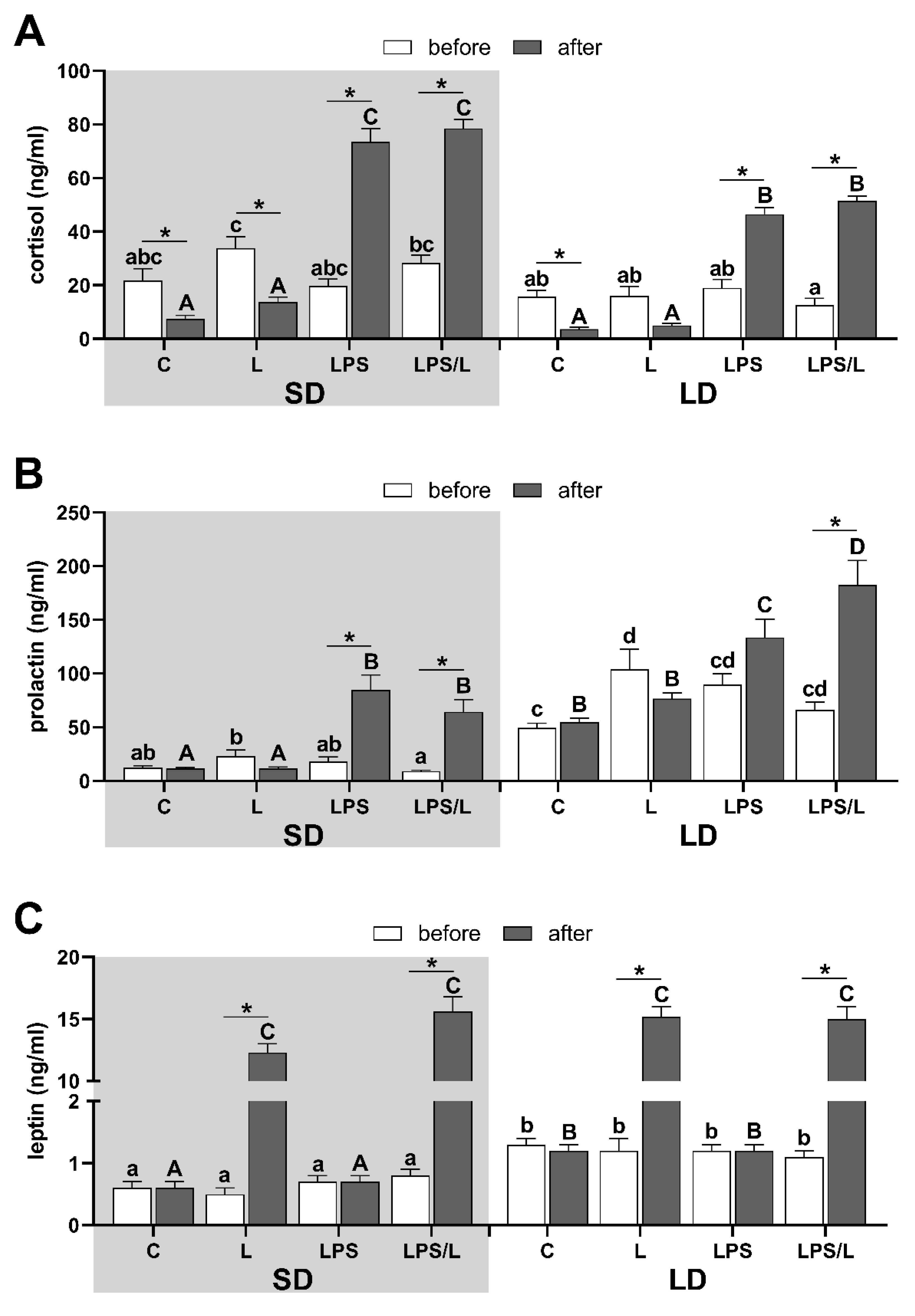
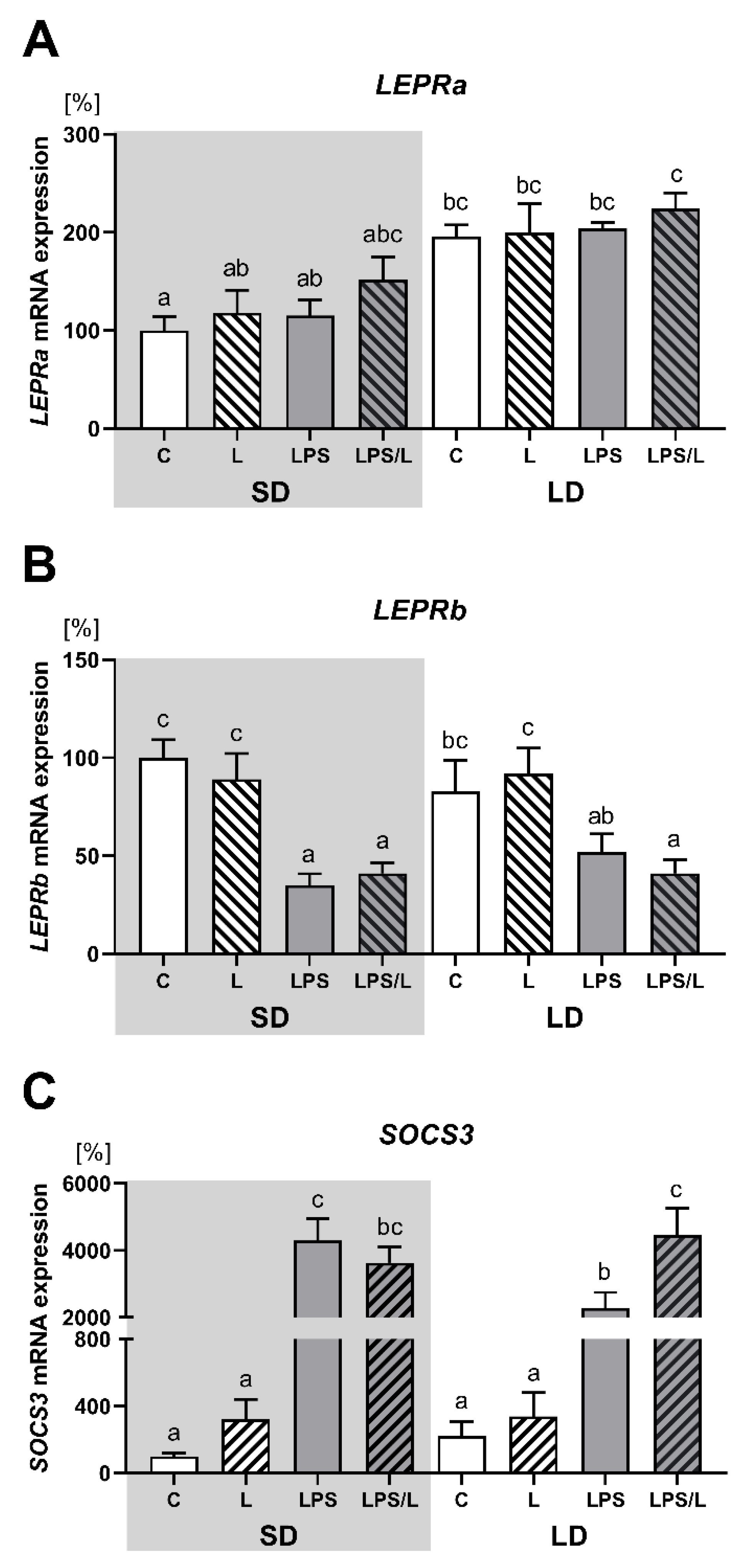

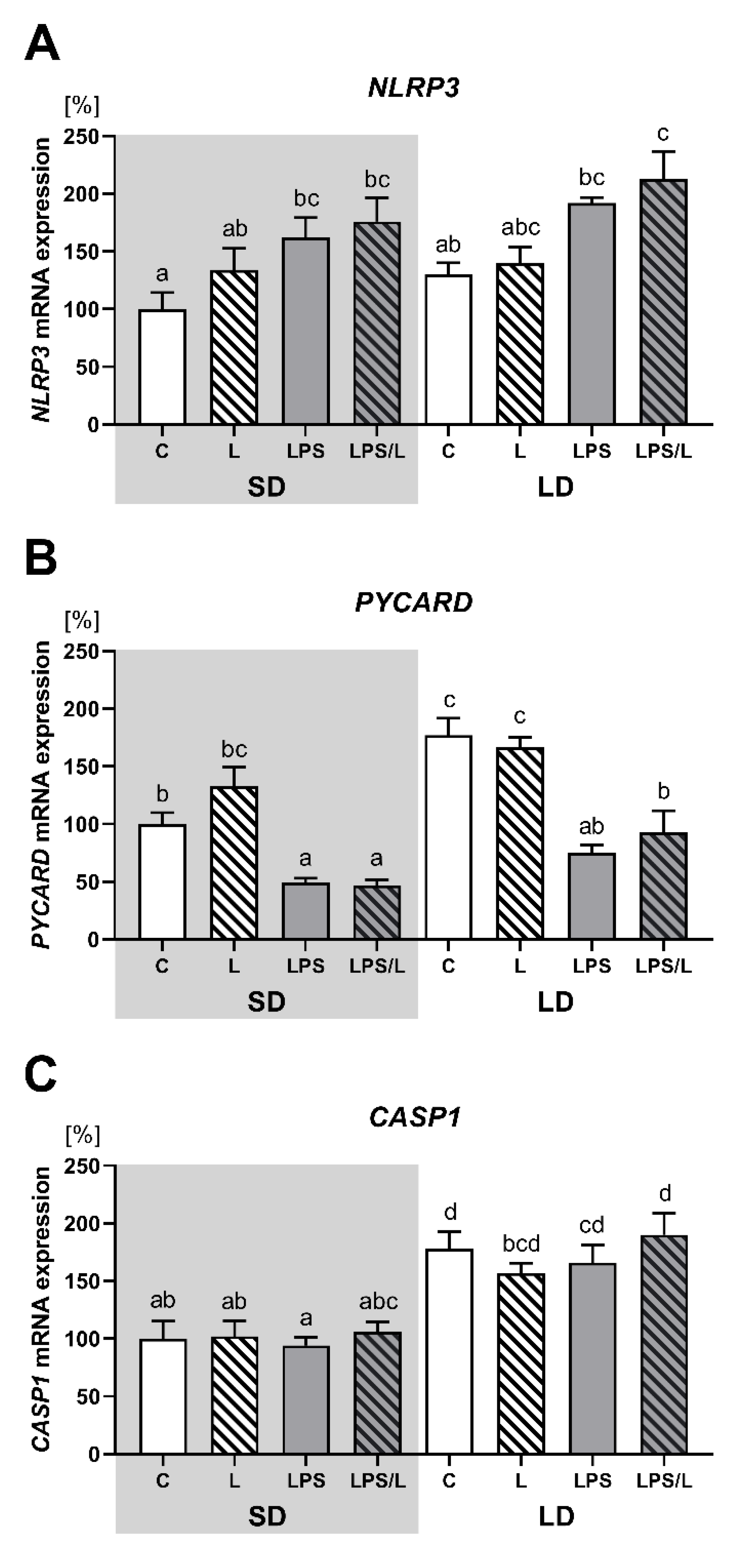
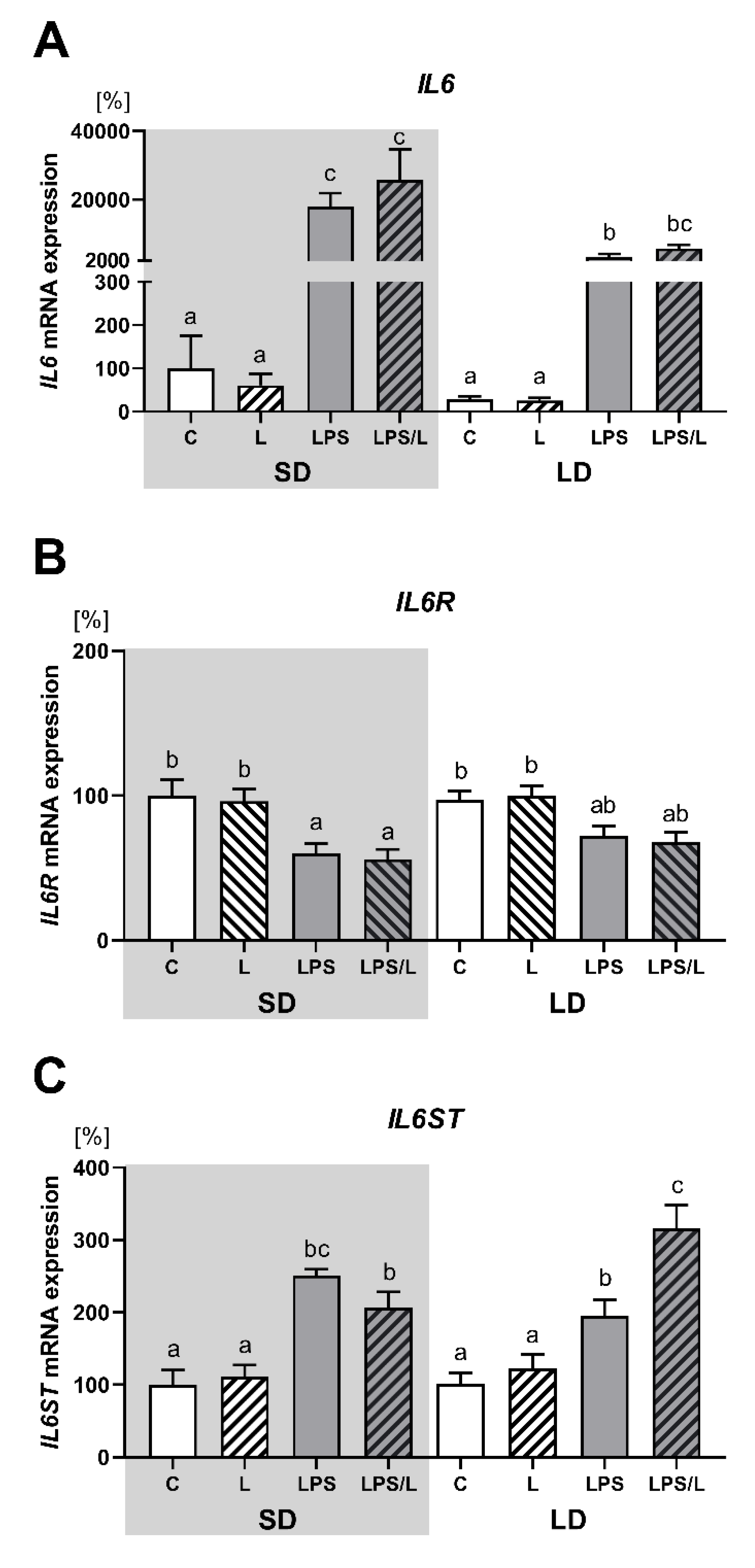
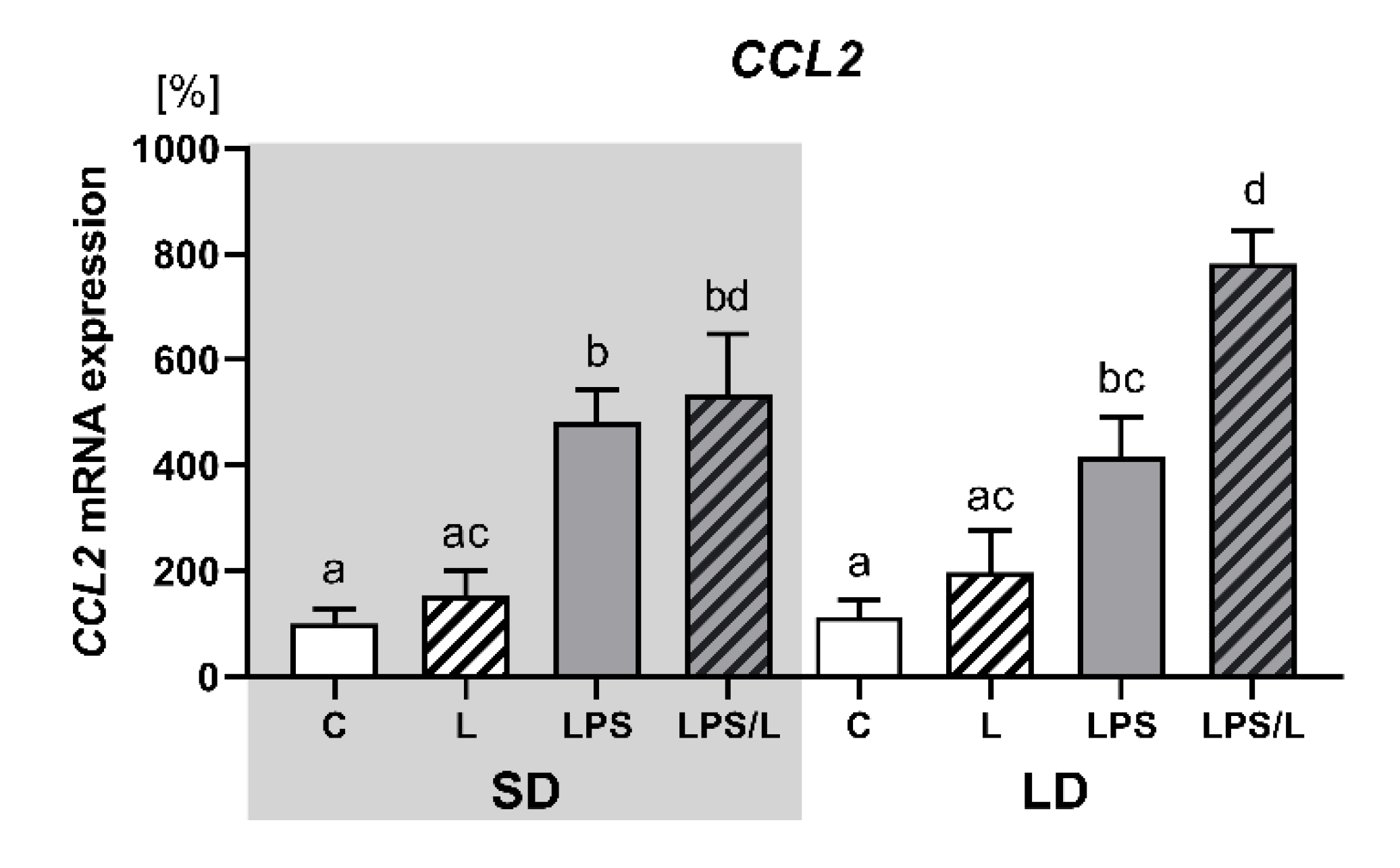
| Gene | (Forward/Reverse) Sequence 5′→3′ | Amplicon Size (bp) | References/Sources | |
|---|---|---|---|---|
| LEPRa | F: TGCTGTCACCCAGTGATTACAATC | R: CAAAGTATGTCCGTTCTCTTCTGA | 412 | [72] |
| LEPRb | F: AACTACAGATGCCCTGCTTTTGAC | R: CCTTTGGTGGAGAATGGTTGC | 257 | [72] |
| SOCS3 | F: TTTCTCGTAGGAGTCCAGGTG | R: CCCCCAGGAGAGCCTATTAC | 140 | XM_027974200.1 |
| TLR4 | F: TGGATTTATCCAGATGCGAAA | R: GGCCACCAGCTTCTGTAAAC | 152 | [73] |
| IL1B | F: CAGCCGTGCAGTCAGTAAAA | R: GAAGCTCATGCAGAACACCA | 137 | [74] |
| IL1R1 | F: GGGAAGGGTCCACCTGTAAC | R: ACAATGCTTTCCCCAACGTA | 124 | [74] |
| IL1R2 | F: CGCCAGGCATACTCAGAAA | R: GAGAACGTGGCAGCTTCTTT | 162 | [74] |
| IL1RN | F: AGGATCTGGGATGTCAACCA | R: CATGGATCCCCAGGAACATA | 145 | [74] |
| NLRP3 | F: CCGTCTGGGTGAGAGCGTGAA | R: TCCTGTTGGCTCCTGTGTTCCT | 78 | [75] |
| PYCARD | F: GCCGTGGACCTTACCGACAA | R: GCAGTCCTGGCTTGGCTATCTT | 110 | [75] |
| CASP1 | F: GGATACAATAAATGGCTTGCTGG | R: CTCGGGCTTTATCCATAGTTGT | 196 | [75] |
| IL6 | F: GTTCAATCAGGCGATTTGCT | R: CCTGCGATCTTTTCCTTCAG | 165 | [74] |
| IL6R | F: TCAGCGACTCCGGAAACTAT | R: CCGAGGACTCCACTCACAAT | 149 | [74] |
| IL6ST | F: GGCTTGCCTCCTGAAAAACC | R: ACTTCTCTGTTGCCCACTCAG | 139 | [76] |
| CCL2 | F: CTCGCTCAGCCAGATGCAAT | R: AGGTTGGGGTCTGCACAAAA | 173 | XM_004012471.3 |
| GAPDH * | F: TGACCCCTTCATTGACCTTC | R: GATCTCGCTCCTGGAAGATG | 143 | [77] |
| ACTB * | F: GCCAACCGTGAGAAGATGAC | R: TCCATCACGATGCCAGTG | 122 | [77] |
| HDAC1 * | F: CTGGGGACCTACGGGATATT | R: GACATGACCGGCTTGAAAAT | 115 | [77] |
Publisher’s Note: MDPI stays neutral with regard to jurisdictional claims in published maps and institutional affiliations. |
© 2020 by the authors. Licensee MDPI, Basel, Switzerland. This article is an open access article distributed under the terms and conditions of the Creative Commons Attribution (CC BY) license (http://creativecommons.org/licenses/by/4.0/).
Share and Cite
Szczepkowska, A.; Kowalewska, M.; Krawczyńska, A.; Herman, A.P.; Skipor, J. Photoperiod Affects Leptin Action on the Choroid Plexus in Ewes Challenged with Lipopolysaccharide—Study on the mRNA Level. Int. J. Mol. Sci. 2020, 21, 7647. https://doi.org/10.3390/ijms21207647
Szczepkowska A, Kowalewska M, Krawczyńska A, Herman AP, Skipor J. Photoperiod Affects Leptin Action on the Choroid Plexus in Ewes Challenged with Lipopolysaccharide—Study on the mRNA Level. International Journal of Molecular Sciences. 2020; 21(20):7647. https://doi.org/10.3390/ijms21207647
Chicago/Turabian StyleSzczepkowska, Aleksandra, Marta Kowalewska, Agata Krawczyńska, Andrzej P. Herman, and Janina Skipor. 2020. "Photoperiod Affects Leptin Action on the Choroid Plexus in Ewes Challenged with Lipopolysaccharide—Study on the mRNA Level" International Journal of Molecular Sciences 21, no. 20: 7647. https://doi.org/10.3390/ijms21207647
APA StyleSzczepkowska, A., Kowalewska, M., Krawczyńska, A., Herman, A. P., & Skipor, J. (2020). Photoperiod Affects Leptin Action on the Choroid Plexus in Ewes Challenged with Lipopolysaccharide—Study on the mRNA Level. International Journal of Molecular Sciences, 21(20), 7647. https://doi.org/10.3390/ijms21207647





